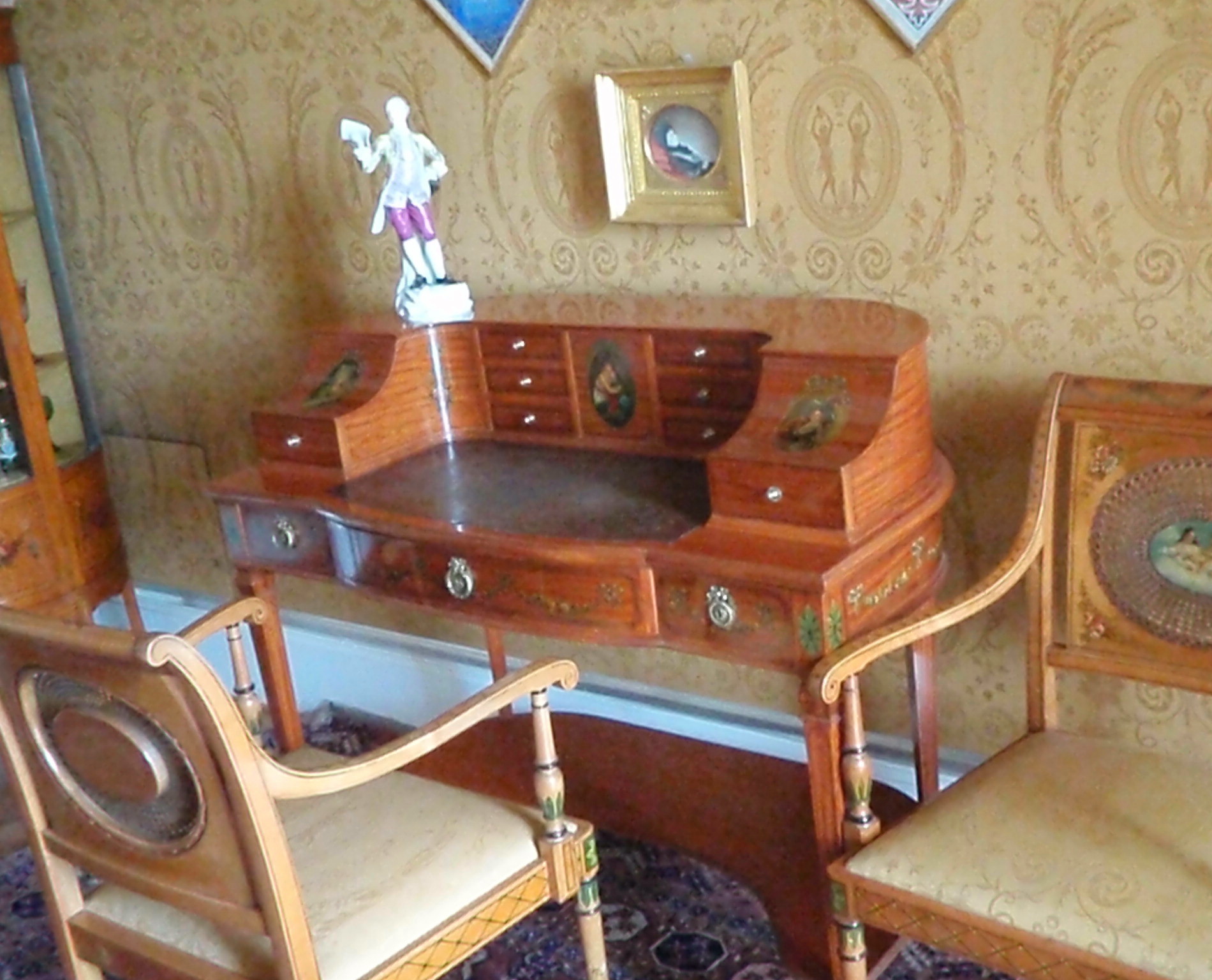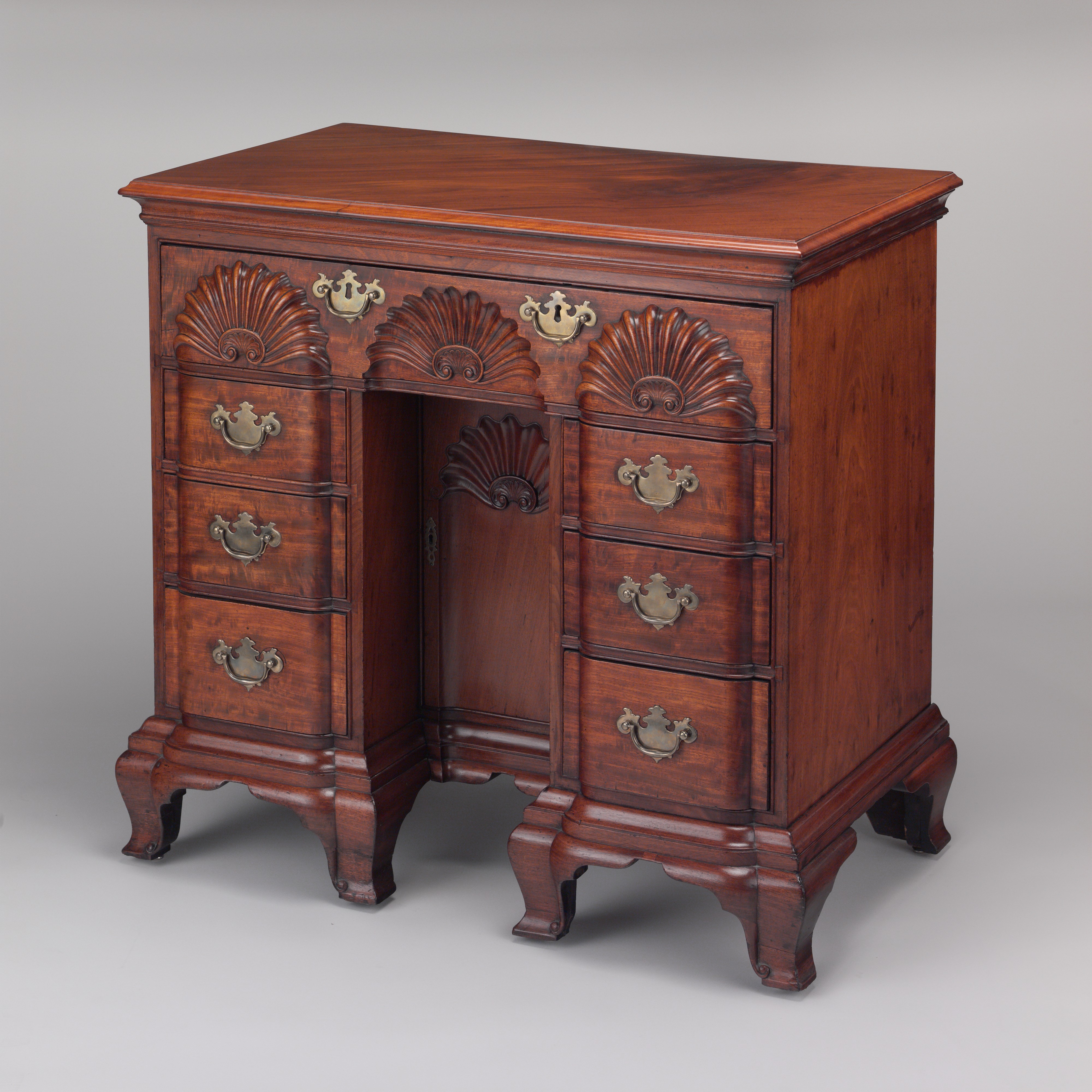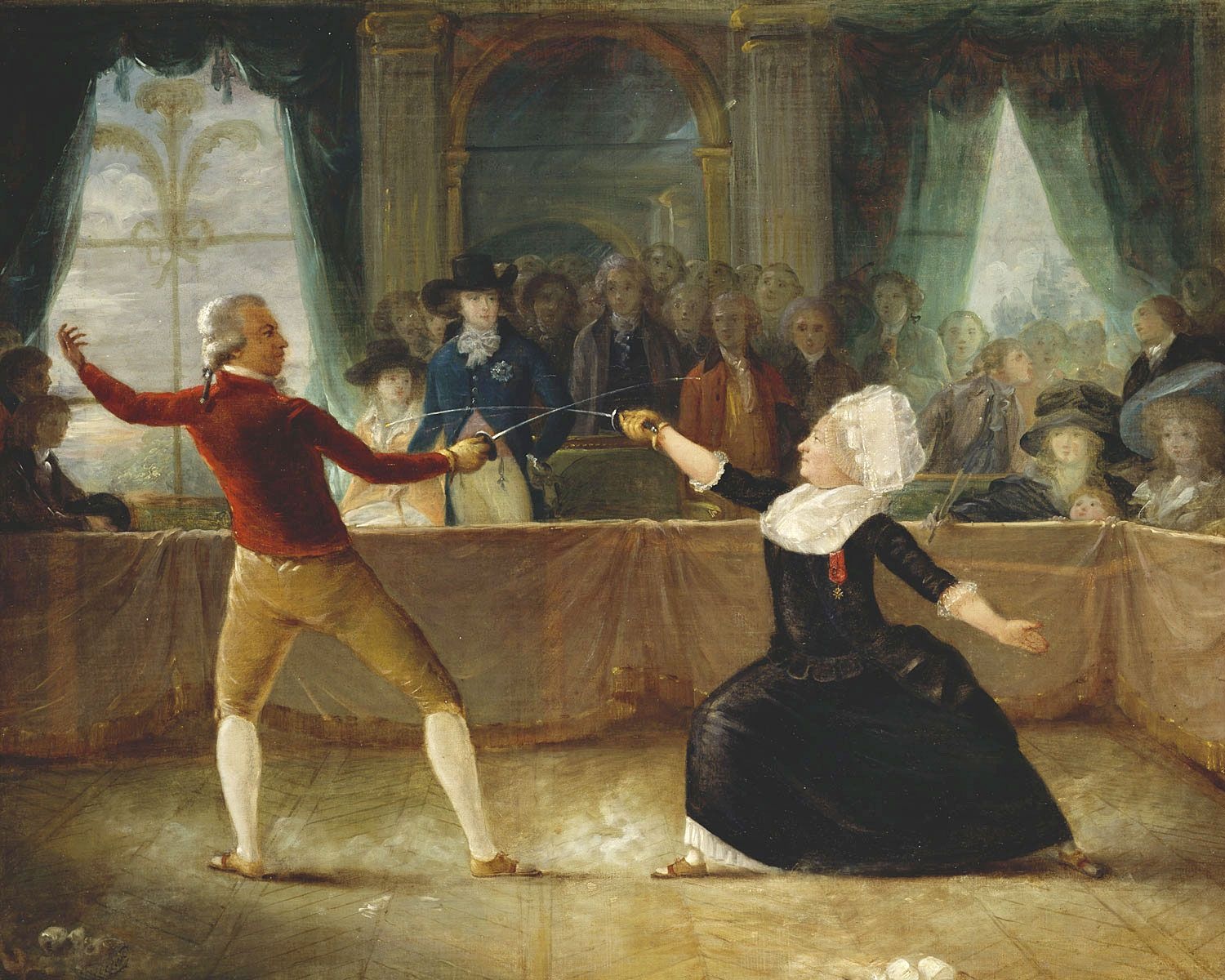|
Carlton House Desk
A Carlton House desk is a specific antique desk form within the more general bureau à gradin form. This form of desk is supposed to have been designed in the 18th century for the Prince of Wales (who later became George IV) by George Hepplewhite. It is named after Carlton House, which was at the time the London residence of the Prince, and sometimes is also known as a Carlton House writing table. The desk resembles a normal writing table, but small drawers above the surface form a "U" shape around the user, instead of merely facing the user as in a typical bureau à gradin. Unlike other types of bureau à gradin, the Carlton House desk usually offers no pigeonholes. There are usually small slopes over each of the desktop drawers at the left and right ends of the "U" shape. Drawings of this type of desk were presented by Hepplewhite in his noted design book, the '' Cabinet-Maker and Upholsterer's Guide'', and by Thomas Sheraton in his own book of designs, ''The Cabinet Maker and U ... [...More Info...] [...Related Items...] OR: [Wikipedia] [Google] [Baidu] |
Desk
A desk or bureau is a piece of furniture with a flat table (furniture), table-style work surface used in a school, office, home or the like for academic, professional or domestic activities such as reading (activity), reading, writing, or using equipment such as a computer. Desks often have one or more Drawer (furniture), drawers, compartments, or pigeonholes to store items such as office supplies and papers. Desks are usually made of wood or metal, although materials such as glass are sometimes seen. Some desks have the form of a table (furniture), table, although usually only one side of a desk is suitable to sit at (there are some exceptions, such as a partners desk), unlike most usual tables. Some desks do not have the form of a table, for instance, an armoire desk is a desk built within a large wardrobe-like cabinet (furniture), cabinet, and a portable desk is light enough to be placed on a person's lap. Since many people lean on a desk while using it, a desk must be sturdy. ... [...More Info...] [...Related Items...] OR: [Wikipedia] [Google] [Baidu] |
Bureau à Gradin
A bureau à gradin is an antique desk form resembling a writing table with, in addition, one or several tiers of small drawers and pigeonholes built on part of the desktop surface. Usually the drawers and pigeonholes directly face the user, but they can also surround three sides of the desk, as is the case for the Carlton house desk form. A small, portable version is a bonheur du jour. In some cases the bureau à gradin has a second tier of drawers under the work surface, and thus looks like an advanced form of the bureau Mazarin or like a non-enclosed version of the cylinder desk, or the tambour desk. See also the List of desk forms and types This is a list of different types and forms of desks. Desk forms and types *Armoire desk *Bargueño desk * Bible box * Bonheur du jour *Bureau à gradin * Bureau brisé * Bureau capucin *Bureau Mazarin *''Bureau plat'', see Writing table * Butl .... References *Souchal, Genevieve. ''French Eighteenth Century Furniture''. Transla ... [...More Info...] [...Related Items...] OR: [Wikipedia] [Google] [Baidu] |
George IV Of The United Kingdom
George IV (George Augustus Frederick; 12 August 1762 – 26 June 1830) was King of the United Kingdom of Great Britain and Ireland and King of Hanover from the death of his father, King George III, on 29 January 1820, until his own death ten years later. At the time of his accession to the throne, he was acting as Prince Regent, having done so since 5 February 1811, during his father's final mental illness. George IV was the eldest child of King George III and Queen Charlotte. He led an extravagant lifestyle that contributed to the fashions of the Regency era. He was a patron of new forms of leisure, style and taste. He commissioned John Nash to build the Royal Pavilion in Brighton and remodel Buckingham Palace, and commissioned Jeffry Wyatville to rebuild Windsor Castle. George's charm and culture earned him the title "the first gentleman of England", but his dissolute way of life and poor relationships with his parents and his wife, Caroline of Brunswick, earned him t ... [...More Info...] [...Related Items...] OR: [Wikipedia] [Google] [Baidu] |
George Hepplewhite
George Hepplewhite (1727? – 21 June 1786) was a cabinetmaker. He is regarded as having been one of the "big three" English furniture makers of the 18th century, along with Thomas Sheraton and Thomas Chippendale. There are no pieces of furniture made by Hepplewhite or his firm known to exist but he gave his name to a distinctive style of light, elegant furniture that was fashionable between about 1775 and 1800 and reproductions of his designs continued through the following centuries. One characteristic that is seen in many of his designs is a shield-shaped chair back, where an expansive shield appeared in place of a narrower splat design. Life and work Very little is known about Hepplewhite himself. Some established sources list no birth information; however a "George Hepplewhite" was born in 1727 in Ryton, County Durham, England. According to some sources, he served his apprenticeship with Gillows in Lancaster, but the Oxford Dictionary of National Biography is scepti ... [...More Info...] [...Related Items...] OR: [Wikipedia] [Google] [Baidu] |
Carlton House, London
Carlton House was a mansion in Westminster, best known as the town residence of King George IV. It faced the south side of Pall Mall, and its gardens abutted St James's Park in the St James's district of London. The location of the house, now replaced by Carlton House Terrace, was a main reason for the creation of John Nash's ceremonial route from St James's to Regent's Park via Regent Street, Portland Place and Park Square: Lower Regent Street and Waterloo Place were originally laid out to form the approach to its front entrance. An existing house was rebuilt at the beginning of the eighteenth century for Henry Boyle, created Baron Carleton in 1714, who bequeathed it to his nephew, the architect Lord Burlington. Burlington's mother sold it in 1732 to Frederick, Prince of Wales, for whom William Kent laid out the garden. Frederick's widow Augusta, Princess of Wales, enlarged the house; in 1783, when Frederick's grandson George, Prince of Wales, was granted possession of Ca ... [...More Info...] [...Related Items...] OR: [Wikipedia] [Google] [Baidu] |
London
London is the capital and largest city of England and the United Kingdom, with a population of just under 9 million. It stands on the River Thames in south-east England at the head of a estuary down to the North Sea, and has been a major settlement for two millennia. The City of London, its ancient core and financial centre, was founded by the Romans as '' Londinium'' and retains its medieval boundaries.See also: Independent city § National capitals The City of Westminster, to the west of the City of London, has for centuries hosted the national government and parliament. Since the 19th century, the name "London" has also referred to the metropolis around this core, historically split between the counties of Middlesex, Essex, Surrey, Kent, and Hertfordshire, which largely comprises Greater London, governed by the Greater London Authority.The Greater London Authority consists of the Mayor of London and the London Assembly. The London Mayor is distinguished fr ... [...More Info...] [...Related Items...] OR: [Wikipedia] [Google] [Baidu] |
Carlton House Desk
A Carlton House desk is a specific antique desk form within the more general bureau à gradin form. This form of desk is supposed to have been designed in the 18th century for the Prince of Wales (who later became George IV) by George Hepplewhite. It is named after Carlton House, which was at the time the London residence of the Prince, and sometimes is also known as a Carlton House writing table. The desk resembles a normal writing table, but small drawers above the surface form a "U" shape around the user, instead of merely facing the user as in a typical bureau à gradin. Unlike other types of bureau à gradin, the Carlton House desk usually offers no pigeonholes. There are usually small slopes over each of the desktop drawers at the left and right ends of the "U" shape. Drawings of this type of desk were presented by Hepplewhite in his noted design book, the '' Cabinet-Maker and Upholsterer's Guide'', and by Thomas Sheraton in his own book of designs, ''The Cabinet Maker and U ... [...More Info...] [...Related Items...] OR: [Wikipedia] [Google] [Baidu] |
Cabinet Maker And Upholsterers Guide
The ''Cabinet-Maker and Upholsterer's Guide'' is a famous antiquarian book, reference book, and non-fiction work. Many cabinetmakers and furniture designers still use it as a ready reference for making period furniture or designs inspired by the late 18th century era. Historians of domestic life or the History of Technology use it for establishing context for their research. Finally, collectors are willing to pay a good sum for the original editions. The sub-title on the original edition is ''Repository of Designs for Every Article of Household Furniture, in the Newest and Most Approved Taste''. This may vary, depending on the edition and the printing. In a technical sense the book is only attributed to George Hepplewhite as author since it was published after his death and the original title page bears the name "A. Hepplewhite and co.", for Alice Hepplewhite, his widow. Very little is known of George Hepplewhite's life, unlike that of the other two great British cabinet makers o ... [...More Info...] [...Related Items...] OR: [Wikipedia] [Google] [Baidu] |
Thomas Sheraton
Thomas Sheraton (1751 – 22 October 1806) was a furniture designer, one of the "big three" English furniture makers of the 18th century, along with Thomas Chippendale and George Hepplewhite. Sheraton gave his name to a style of furniture characterized by a feminine refinement of late Georgian styles and became the most powerful source of inspiration behind the furniture of the late 18th century. Biography Sheraton was born in Stockton-on-Tees, County Durham, England - where nowadays there is a pub named after him. He was one of the leaders and preachers of the Stockton Baptist church and also preached elsewhere on his travels. He was apprenticed to a local cabinet maker and continued working as a journeyman cabinet maker until he moved to London in 1790, aged 39. There he set up as professional consultant and teacher, teaching perspective, architecture, and cabinet design for craftsmen. It is not known how he gained either the knowledge or the reputation which enabled him to do ... [...More Info...] [...Related Items...] OR: [Wikipedia] [Google] [Baidu] |
List Of Desk Forms And Types
This is a list of different types and forms of desks. Desk forms and types *Armoire desk *Bargueño desk * Bible box * Bonheur du jour *Bureau à gradin * Bureau brisé * Bureau capucin *Bureau Mazarin *''Bureau plat'', see Writing table * Butler's desk *Campaign desk *Carlton house desk *Carrel desk * Cheveret desk * Computer desk *Credenza desk * Cubicle desk *Cylinder desk *Davenport desk * Desk and bench * Desk on a chest * Desk on a frame *Drawing table * Ergonomic desk * Escritoire * Fall-front desk * Field desk *Fire screen desk *Games table desk * Lap desk *Lectern desk * Liseuse desk *Mechanical desk * Metamorphic library steps *Moore desk *Partners desk *Pedestal desk * Plantation desk *Portable desk *Rolltop desk * School desk *''Secrétaire à abattant'', see Fall-front desk * Secretaire en portefeuille *Secretary desk *Shtender * Slant-top desk * Spinet desk *Standing desk * Student desk *Tambour desk *''Tanker desk'', see Pedestal desk *Telephone desk * Treadmill d ... [...More Info...] [...Related Items...] OR: [Wikipedia] [Google] [Baidu] |



